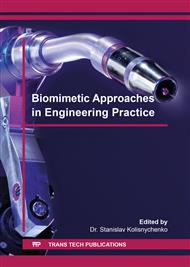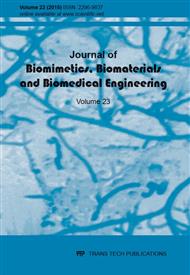[1]
Gu Y Q, Ru J, Zhao G, Li Z Y, Liu W B, Farid M. Influence of jet hole configuration on drag reduction of bionic jet surface. Applied Mechanics and Materials, 2014, 461, pp.725-730.
DOI: 10.4028/www.scientific.net/amm.461.725
Google Scholar
[2]
Moore A R, Lowson M V. Drag reduction in a rectangular duct using riblets. Aeronautical Journal, 1995, 99(985), pp.187-193.
DOI: 10.1017/s0001924000028360
Google Scholar
[3]
Lu Y X. Significance and progress of bionics. Journal of Bionics Engineering, 2004, 1(1), pp.1-3.
Google Scholar
[4]
Ball P. Life's lessons in design [J]. Nature, 2001, 409: 413-416.
Google Scholar
[5]
Carpenter P W. Optimization of multiple-panel compliant walls for delay of laminar-turbulent transiton. AIAA Journal, 1993, 31(7), pp.1187-1188.
DOI: 10.2514/3.11750
Google Scholar
[6]
Kramer M O. Boundary layer stabilization by distributed damping. Naval Engineers Journal, 1962, 74(2), pp.341-348.
DOI: 10.1111/j.1559-3584.1962.tb05568.x
Google Scholar
[7]
Zheng Z C. Effects of flexible walls on radiated sound from a turbulent boundary layer. Fluids and Structures, 2003, 18(1), pp.93-101.
DOI: 10.1016/s0889-9746(03)00081-1
Google Scholar
[8]
Pavlov V V. Dolphin skin as a natural anisotropic compliant wall. Bioinspiration & Biomimetics, 2006, 1(2), pp.31-40.
DOI: 10.1088/1748-3182/1/2/001
Google Scholar
[9]
Fish F E. The myth and reality of gray's paradox: implication of dolphin drag reduction for technology. Bioinspration & Biominetics, 2006, 1(2), pp.17-25.
Google Scholar
[10]
Kulik V M, Semenov B N. The measurement of dynamic properties of viscoelastic materials for turbulent drag reduction/European Drag Reduction Meeting, Emerging Techniques in Drag Reduction. London: Mechanical Engineering Publications, 1996, pp.207-217.
DOI: 10.1002/9781118181096.ch6
Google Scholar
[11]
Choi K S, Yang X, Clayton B R, Glover E J, Atlar M, Semenov B N, Kulik V M. Turbulent drag reduction using compliant surfaces. Proceedings of the Royal Society of London, Series A: Mathematical, Physical and Engineering Sciences, l997, 453(1965).
DOI: 10.1098/rspa.1997.0119
Google Scholar
[12]
Liu Z H, Dong W C, Xiong Y, Xia F. Analysis on factor s and mechanism of drag reduction by grooved surface. Journal of Ship Mechanics, 2007, 11(6), pp.820-831.
Google Scholar
[13]
Carpenter P W. Optimization of multiple-panel compliant walls for delay of laminar-turbulent transition. AIAA Journal, 1993, 31(7), pp.1187-1188.
DOI: 10.2514/3.11750
Google Scholar
[14]
Dixon A E, Lucey A D, Carpenter P W. Optimization of viscoelastic compliant walls for transition delay. AIAA Journal, 1994, 32(2), pp.256-267.
DOI: 10.2514/3.11980
Google Scholar
[15]
Lee T, Fisher M, Schwarz W H. Investigation of the stable interaction of a passive compliant surface with a turbulent boundary layer. Journal of Fluid Mechanics, 1993, 257, pp.373-401.
DOI: 10.1017/s002211209300312x
Google Scholar
[16]
Huang J C, Johnson M W. Boundary layer receptivity measurements on compliant surfaces. International Journal of Heat and Fluid Flow, 2008, 29(2), pp.495-503.
DOI: 10.1016/j.ijheatfluidflow.2007.11.004
Google Scholar
[17]
Zhao X C, Zhang J, Wang B Z, Lu F. Experiment of drag-reducing property and research of drag-reducing principle for compliant skin. Journal of Ship Mechanics, 2004, 8(4), pp.16-21.
Google Scholar
[18]
Zhao X C. Applying flexible layer technique to new concept submarine. Journal of Ship Mechanics, 2003, 7(1), pp.112-115.
Google Scholar
[19]
Breuer K S, Haritionidis J H, Landahl M T. The control of transient disturbances in a flat plate boundary layer through active wall motion. Physics of Fluids, 1989, 1(3), pp.574-582.
DOI: 10.1063/1.857426
Google Scholar
[20]
Kang S, Choi H. Active wall motions for skin-friction drag reduction. Physics of Fluids, 2000, 12(12), pp.3301-3304.
DOI: 10.1063/1.1320833
Google Scholar
[21]
Kulik V M, Rodyakin S V, Suh S B, Lee I, Chun H H. The response of compliant coating to nonstationary disturbances. Physics of Fluids, 2005, 17(8), pp.088104-4.
DOI: 10.1063/1.2011467
Google Scholar
[22]
Gu J N, Yan X, Zhang Z H, Zhao X. Experimental investigation of drag-reducing for compliant wall by PIV measurement. Ship Science and Technology, 2012, 34(11), pp.82-85.
Google Scholar
[23]
Yao Y, Lu C J, Si T, Zhu K. Water tunnel experimental investigation on the drag reduction characteristics of the traveling wavy wall. Journal of Hydrodynamics: Series B, 2011, 23(1), pp.65-70.
DOI: 10.1016/s1001-6058(10)60089-3
Google Scholar
[24]
Huang Jui-Che, Johnson M W. The influence of compliant surfaces on bypass transition. Experiments in Fluids, 2007, 42(5), pp.711-718.
DOI: 10.1007/s00348-007-0278-2
Google Scholar
[25]
Luo H X, Thomas R B. Accurate simulation of near-wall turbulence over a compliant tensegrity fabric. Smart Structures and Materials 2005: Modeling, Signal Processing, and Control, 2005, 5757, pp.184-197.
DOI: 10.1117/12.600582
Google Scholar
[26]
Wang Y C, Jiang N, Zhou X H, Shu W. The experimental investigation of coherent structure control in turbulent boundary layer over compliant wall. Journal of Experimental Mechanics, 2004, 19(1), pp.45-50.
Google Scholar
[27]
Zhao H Z. Influence of compliant wall on velocity profile deformation in a turbulent boundary layer. Journal of Hydrodynamics: Series A, 2002, 17(4), pp.391-399.
Google Scholar
[28]
Tian L M, Gao Z H, Wang Y C, Ren L Q, Shang Z. Design and experiment of bionic coupling functional surface caused by dual factors of form and flexible material. Journal of Jilin University: Engineering and Technology Edition, 2013, 43(4), pp.970-975.
Google Scholar
[29]
Dou Z L, Wang J D, Chen D R. Research on drag reduction mechanism of polymer coating with binary structured surface. Journal of Functional Materials, 2012, 43(24), pp.3351-3354.
Google Scholar
[30]
Wei J J, Kawaguchi Y, Yu B, Li L C. Brownian dynamics simulation of microstructures and elongational viscosities of micellar surfactant solution. Chinese Physics Letters, 2008, 25(12), pp.4469-4472.
DOI: 10.1088/0256-307x/25/12/080
Google Scholar
[31]
Wei J J, Kawaguchi Y, Yu B, Li F C, Zhang C W. Microstructures and rheology of micellar surfactant solution by brownian dynamics simulation. Nonlinear Dynamics, 2010, 61(3), pp.503-515.
DOI: 10.1007/s11071-010-9667-9
Google Scholar
[32]
Zhang C W, Wei J J. Simulation study of flexible micelles in dilute surfactant solutions. Journal of Engineering Thermophysics, 2013, 34(6), pp.1084-1086.
Google Scholar
[33]
Padding J T, Boek E S, Briels W J. Dynamics and rheology of wormlike micelles emerging from particulate computer simulations. Journal of Chemical Physics, 2008, 129(7), pp.074903-11.
DOI: 10.1063/1.2970934
Google Scholar
[34]
Ge W, Shi H F, Zakin J L. Rheo-optics of cationic surfactant micellar solutions with mixed aromatic counterions. Rheologica Acta, 2012, 51(3), pp.249-258.
DOI: 10.1007/s00397-011-0604-8
Google Scholar



